Agra Landmarks and Monuments
(Agra, Uttar Pradesh, India)
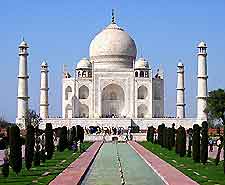
The Indian city of Agra contains a number of outstanding and simply breathtaking monuments, Mughal temples and landmarks, none of which are more impressive than the Taj Mahal, a World Heritage Site. Agra is so famous for being home to the Taj Mahal that it is often nicknamed the 'Taj City'.
Many other significant landmarks also lie around Agra and include the eye-catching Agra Fort, which is yet another World Heritage Site and often referred to as the city's Red Fort, due to its striking red-sandstone facade. Also worth visiting in Agra are the Chini Ka Rauza, the Soami Bagh Samadh and Itmad-Ud-Daulah's Tomb. Agra's most visited landmarks and monuments are described here.
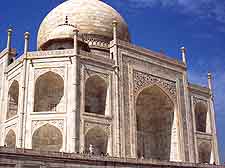
Taj Mahal
Tel: +91 0562 233 0498
Famous the world over for its spectacular white-marble architecture, the Taj Mahal is one of India's most visited landmarks. This magnificent Mughal mausoleum is now a World Heritage Site and was commissioned by the Emperor Shah Jahan, as a particularly grand memorial to the wife Mumtaz Mhal, who sadly died during child birth. Construction of Agra's Taj Mahal started in 1631 and was complete some 25 years later, with a team of more than 20,000 people working on this building, including architects from as far as Europe. Expect to see elaborate marble inlays ('pietra dura'), literally thousands of beautiful semi-precious stones and jewels, and reflections in the watercourse, within the landscaped formal gardens.
Open hours: Saturday to Thursday - 06:00 to 19:00
Admission: charge
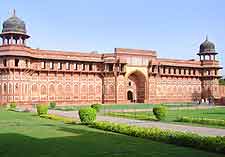
Agra Fort / Red Fort
Tel: +91 0562 236 4512
Located alongside the Yamuna River and built in the mid-16th century by the Emperor Akbar, the Agra Fort was built as a military structure, being upgraded to the spacious palace complex some years later. The Amar Singh Gate provides entry to the fort on the southern side, with the main highlights and monuments including the Anguri Bagh gardens, Colvin's Tomb, Diwan-i-Khas (Hall of Private Audiences), the Government Bookshop, Jehangir's Palace, the Ladies' Bazaar, the
Moti Masjid (Pearl Mosque), the Nagina Masjid (Gem Mosque) and the Shish Mahal (Mirror Palace).
Open hours: daily - dawn to dusk
Admission: charge
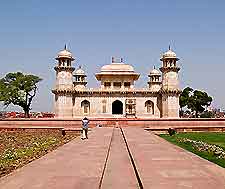
Itmad-Ud-Daulah's Tomb
Tel: +91 0562 208 0030
Agra's Itmad-Ud-Daulah's Tomb is known by many as the 'Baby Taj Mahal', due to its similar appearance. Built during the early part of the 17th century and situated on the banks of the Yamuna River, the Itmad-Ud-Daulah was the first ever Mughal structure to be completely built with marble and is the tomb of Mizra Ghiyas Beg. The peaceful gardens boast a series of walkways and inter-connecting watercourses.
Open hours: daily - 06:30 to 17:30
Admission: charge
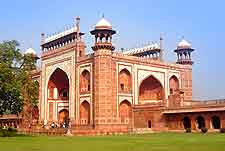
Chini Ka Rauza
Known for its Persian-style architecture, enamel tiles and elaborate, floral interior, the Chini Ka Rauza is the tomb of Afzal Khan. Construction of the Chini Ka Rauza began in 1628 and was finally completed some ten years later. This appealing landmark is often overlooked and enjoys a particularly secluded situation, with good views from the upper floors.
Open hours: daily - 06:00 to 18:00
Admission: charge
Soami Bagh Samadh
Located within the suburbs of Agra, in the Dayalbagh area, the Soami Bagh Samadh mausoleum is the resting place of Huzur Soamiji Maharaj and dates back just over 100 years. Constant improvements are continually being made to the overall structure, including intricate stone carvings, coloured marble and endless photo opportunities.
Open hours: daily
Admission: charge
 The Indian city of Agra contains a number of outstanding and simply breathtaking monuments, Mughal temples and landmarks, none of which are more impressive than the Taj Mahal, a World Heritage Site. Agra is so famous for being home to the Taj Mahal that it is often nicknamed the 'Taj City'.
The Indian city of Agra contains a number of outstanding and simply breathtaking monuments, Mughal temples and landmarks, none of which are more impressive than the Taj Mahal, a World Heritage Site. Agra is so famous for being home to the Taj Mahal that it is often nicknamed the 'Taj City'.


